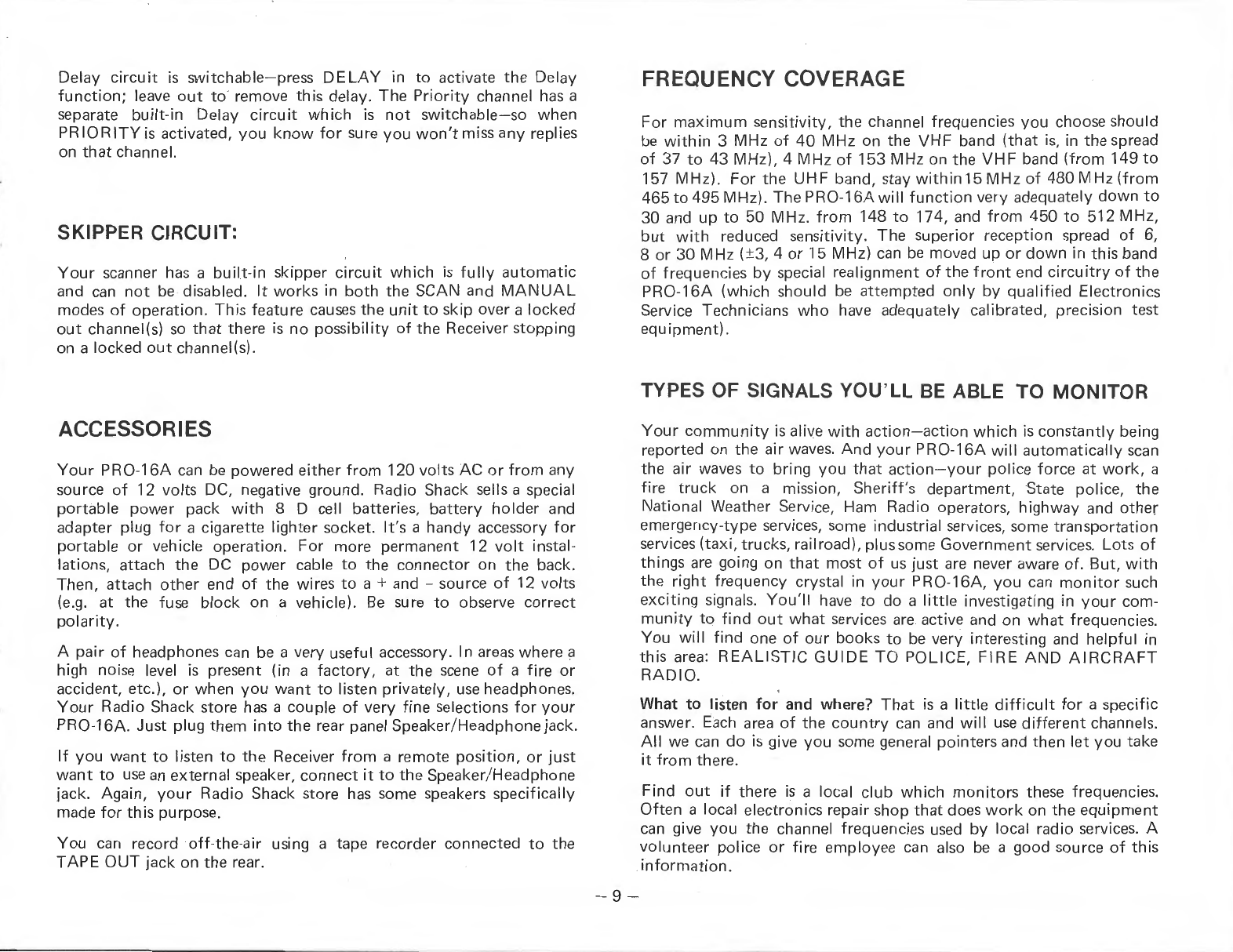
,
Y-
I
,,
I
-
Delay
circuit
is
switchable-press
DE
LAY
in
to
activate
the
Delay
function;
leave
out
to
remove
this
delay.
The
Priority
channel has a
separate
built-in
Delay
circuit
which
is
not
switchable-so
when
PRIORITY
is
activated,
you
know
for
sure
you
won'
t miss
any
repli
es
on
that
channel.
SKIPPER CIRCUIT:
Your
scanner has a
built-in
skipper
circuit
which
is
fully
automatic
and can
not
be
disabled.
It
works
in
both
the
SCAN and
MANUAL
modes
of
operation.
This
feature causes
the
unit
to
skip
over a
loc
ked
out
channel(s)
so
that
there
is
no
possibility
of
the
Receiver
stopping
on a
locked
out
channel(s).
ACCESSORIES
Your
PR0
-
16A
can
be
powered
either
from
120
volts
AC
or
from
any
source
of
12
volts
DC, negative ground. Radio Shack sells a special
portable
power
pack
with
8 D cell batteries,
battery
holder
and
adapter plug
for
a cigarette
lighter
socket.
It's
a
handy
accessory
for
portable
or
vehicle
operation.
For
more
permanent
12
volt
instal-
lations, attach
the
DC
power
cable
to
the
connector
on
the
back.
Then, attach
other
end
of
the
wires
to
a + and - source
of
12
volts
(e.g. at
the
fuse
block
on a vehicle).
Be
sure
to
observe
correct
polarity.
A
pair
of
headphones can be a very useful accessory. In areas where a
high noise level
is
present (in a
factory,
at
the
scene
of
a
fire
or
accident, etc.),
or
when
you
want
to
listen
privately,
use
headphones.
Your
Radio Shack store
has
a couple
of
very
fine
selections
for
your
PR0-16A.
Just plug
them
into
the
rear panel Speaker/Headphone jack.
If
you
want
to
listen
to
the
Receiver
from
a remote
position,
or
just
want
to
use
an
external speaker,
connect
it
to
the
Speaker/Headphone
jack. Again,
your
Radio Shack store has some speakers
specifically
made
for
th
is
purpose.
You
can record
off-the-air
using a tape recorder connected
to
the
TAPE
OUT
jack on
the
rear.
-9
-
FREQUENCY COVERAGE
For
maximum
sensitivity,
the
channel frequencies
you
choose
should
be
within
3
MHz
of
40
MHz
on
the
VHF
band
(that
is,
in
the
spread
of
37
to
43
MHz),
4
MHz
of
153
MHz
on
the
VHF
band
(from
149
to
157
MHz)
.
For
the
UHF
band, stay
within
15
MHz
of
480
MHz
(from
465
to
495
MHz). The
PR0-16A
will
function
very adequately
down
to
30
and
up
to
50
MH
z.
from
148
to
174, and
from
450
to
512
MHz,
but
with
reduced sensitivity.
The
superior reception spread
of
6,
8
or
30
MHz
(±3, 4
or
15 MHz) can
be
moved up
or
down
in
this
band
of
frequencies
by
special realignment
of
the
front
end
circuitry
of
the
PR0-16A
(which
should
be
attempted
only
by
qualified
Electronics
Service Technicians
who
have adequately calibrated, precision test
equipment).
TYPES OF SIGNALS YOU'LL
BE
ABLE TO
MONITOR
Your
community
is
alive
with
action-action
which
is
constantly
being
reported on
the
air waves.
And
your
PR0-16A
will
automatically
scan
the
air
waves
to
bring
you
that
action-your
police
force
at
work,
a
fire
truck
on a mission,
Sheriff's
department,
State police,
the
National Weather Service, Ham Radio operators,
highway
and
other
emergency-type services, some
industrial
services, some
transportation
services (ta
xi,
trucks, railroad), plus some
Government
services.
Lots
of
things are going on
that
most
of
us
just
are never aware
of.
But,
with
the
right
frequency
crystal in
your
PR0-16A,
you
can
monitor
such
exciting
signa
ls
.
You'll
have
to
do
a
little
investigating in
your
com-
munity
to
find
out
what
services
are
active and
on
what
frequencies.
You
will
find
one
of
our
books
to
be
very interesting and
helpful
in
this
area:
REALISTIC
GUIDE
TO
POLICE,
FIRE
AND
AIRCRAFT
RADIO.
What to listen for and where?
That
is
a
little
difficult
for
a specific
answer. Each area
of
the
country
can and
will
use
different
channels.
All
we can
do
is give
you
some general
pointers
and
then
let
you
take
it
from
there.
Find
out
if
there
is
a local
club
which
monitors
these frequencies.
Often
a local electronics repair shop
that
does
work
on
the
equipment
can
give
you
the
channel frequencies
used
by
local radio services. A
volunteer
police
or
fire
employee can also
be
a good source
of
this
information.














